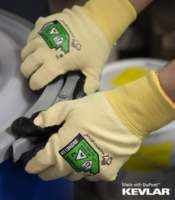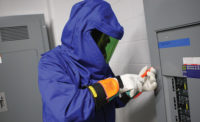The nature of electricity is unlike anything else: invisible and unpredictable. Experts agree it’s hard to anticipate an arc flash occurrence. That’s why it’s critically important to be prepared.
The most crucial question is: “Can we do this work de-energized?” said Mike Balinskas of PowerHawke, Inc.
“Unfortunately, arc flash studies aren’t an exact science. They are snapshots, based on current utility information. As the grid fluctuates over time, so does the hazard exposure. A change in a utility substation transformer will change the calculation results for the electrical distribution equipment of a facility,” said Dave Hill, Intertek Testing. It’s not enough to rely on PPE. Every precaution should be taken to prevent arc flash.
What’s missing from many electrical safety programs is a strategic game plan to address arc flash hazards.
“Effective electrical safety programs begin with achievable goals. Many organizations pursue safety training, arc flash hazard analysis, PPE selection, labeling and electrical safety program development as independent projects, when for an effective safety program, they are really interdependent. Strategic planning can reduce program investment, implementation time and provide enhanced worker safety,” said Gary P. Larkins, APS/PowerSafetyPRO.
“The distance between a lifetime of pain, disfiguration and disability when compared to going home safely is no further than the fraction of an inch air gap that can be ionized to initiate an arc in the presence of significant voltage. Knowing the site and following the rules keep individuals safe and equipment intact,” said Michael Morse, professor of electrical engineering, University of San Diego.
Electrical safety plans must address:
- Training/compliance
- PPE
- Tools/equipment, including labeling systems
Training/compliance
Increase training to keep employees up to speed. How familiar are you with new NFPA requirements and how they apply to your equipment?
Mr. Hill reviews current arc flash NFPA, ANSI, IEEE and NEC information:
- NFPA 70-2011/NEC is the driving document for all electrical installations. The other NFPA, ANSI/UL, IEEE, NEMA and harmonized IEC documents refer back to the NEC for installation practices.
- NFPA 70-2011/NEC Section 110.16 and the Informational Note reference NFPA 70E for guidance of Arc Flash and PPE as well as ANSI Z535.4 for safety warning signage.
- NFPA 70-2011/NEC Section 670.3(A) requires industrial electrical equipment and control panels to have a permanent label denoting short-circuit current rating of the control panel with references to UL 508A Supplement SB as an example of determining the SCCR. Section 409.22 and 409.110(4) are the references for industrial control panels specifically.
- NFPA code calls for labeling electrical panels, disconnects and access points to inform those servicing equipment of potential arc flash hazards present based on studies of the electrical system feeding each location.
- NFPA 70E requires workers to document arc flash analysis calculations used for electrical equipment labeling. Even though NFPA 70E and IEEE 1584 provide standardized calculations for an arc flash analysis, other methods exist, opening the door for variation. Posting key elements of your analysis on electrical equipment will help you remember the methods used after a job is complete.
As of September 30, 2011, NFPA requires labels to display the nominal system voltage, arc flash boundary and one of the following:
- Available incident energy and the corresponding working distance
- Minimum arc rating of clothing
- Required level of PPE
- Highest hazard/risk category (HRC) for the equipment
NFPA’s new standards require that labels display additional information and must be posted on switchboards, panelboards, industrial control panels, meter socket enclosures and motor control centers.
A switchboard is a large single panel, frame or assembly of panels. Switches, overcurrent, other protective devices, buses and usually instruments are mounted on the face, back or both. Switchboards are generally accessible from the rear and the front and not intended to be installed in cabinets.
Panelboards are single panels or groups of panel units designed for assembly in the form of a single panel. These include buses, automatic overcurrent devices and those devices equipped with or without switches for the control of light, heat or power circuits. Panelboards are designed to be placed in a cabinet or cutout box or against a wall, partition or other support and accessible only from the front.
There are two main types of industrial control panels (ICP): enclosed and open ICPs. Enclosed ICPs are installed within a complete enclosure at the panel manufacturer’s location. An open ICP includes factory wiring, field wiring terminals and components mounted on a sub-panel without a complete enclosure. ICPs often contain motor controllers, switches, relays, power supplies, computers, cathode ray tubes, transducers and auxiliary devices used in the manufacturing process to control industrial utilization equipment.
Meter socket enclosures are equipped with matching jaws to accommodate the bayonet-type (blade) terminals of a detachable watt-hour meter. It also has a means of connections for the termination of the circuit conductors. It may be a single-position socket for one meter or a multi-position trough socket for two or more meters.
Motor control centers are unlike other types of power distribution equipment, which are used with a variety of load types. Motor control centers primarily control the distribution of power to electric motors.
PPE
Whether you are in an underground high-voltage transmission system or a substation, personal protective equipment (PPE) reduces exposure hazards. PPE means wearable protective gear: a shielded hood, bibs or coveralls.
Some companies are simplifying PPE by reducing it down to two sets of PPE to wear instead of one for each category. This is touched on in the appendix of the 2012 NFPA book.
Infrared windows
“A key technology ensuring safety is the infrared window. Installed on cabinet panels and doors, IR windows are view ports providing access into electrical cabinets and other enclosures. With an IR window, an electrical worker uses an infrared camera to inspect energized internal electrical components for temperature abnormalities without the direct exposure from removing covers and panels,” said Andre´ Rebelo, FLIR Systems, Inc.
Infrared windows are a framed lens made of special transparent crystal or polymer material allowing infrared spectrum waves to pass through the window making it easy to perform infrared inspections. IR windows have a protective cover to shield the lens when not in use.
Infrared (IR) windows are important to keep in mind when budgets are scrutinized. Your budget may have more dollars available in the workplace safety bucket than in the infrastructure bucket, or vice versa. IR windows are relevant in both cases.
Tools and equipment
New industrial labeling systems are mobile, compatible with many types of software and empower end-users to quickly create custom safety, hazard and warning signs and labels on-site, in sequence. Displaying arc flash calculations on an industrial label offers valuable information to other electrical workers, inspectors and emergency responders.


